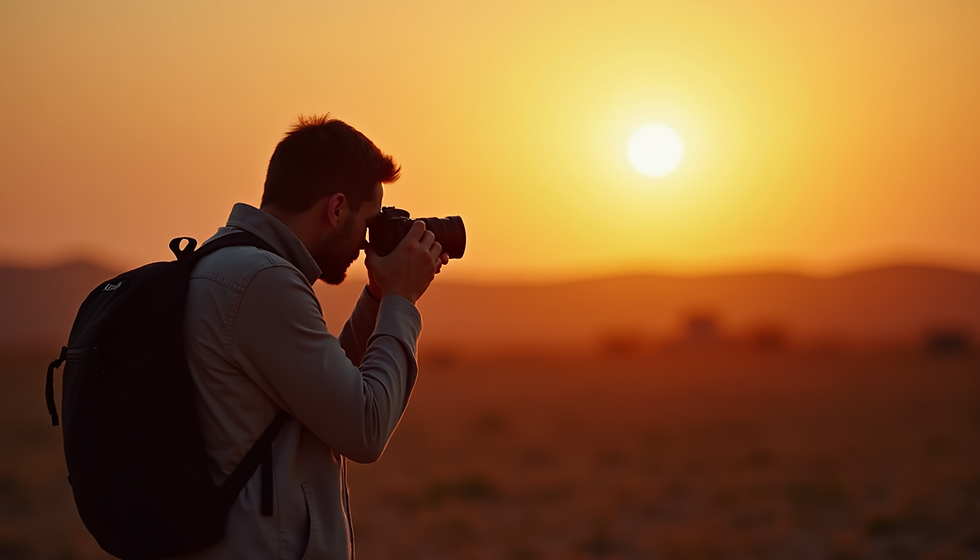Photography Tutorials: Mastering the Art of Picture-Taking
- photokultureca
- Aug 27
- 4 min read
Photography is more than just pressing a button. It is about capturing moments, telling stories, and expressing creativity. Whether you are a beginner or someone looking to refine your skills, this guide will help you master the art of picture-taking.
In this post, we will explore essential techniques, tips, and tricks that can elevate your photography game. From understanding your camera settings to composition and lighting, we will cover it all. So grab your camera, and let’s dive in!
Understanding Your Camera
Before you can take great photos, you need to understand your camera.
Camera Types
There are several types of cameras available today. Here are the most common:
DSLR Cameras: These are versatile and offer high-quality images. They allow for interchangeable lenses and manual settings.
Mirrorless Cameras: These are similar to DSLRs but are typically lighter and more compact. They also offer interchangeable lenses.
Point-and-Shoot Cameras: These are user-friendly and great for beginners. They have automatic settings that make photography easy.
Smartphone Cameras: With advancements in technology, smartphone cameras can produce stunning images. They are convenient and always with you.
Understanding the type of camera you have will help you make the most of its features.
Camera Settings
Familiarize yourself with the basic settings of your camera:
Aperture: This controls the amount of light entering the camera. A lower f-stop number (like f/2.8) means a wider aperture, allowing more light in and creating a blurred background.
Shutter Speed: This determines how long the camera’s shutter is open. A fast shutter speed (like 1/1000) freezes motion, while a slow shutter speed (like 1/30) can create motion blur.
ISO: This measures the camera's sensitivity to light. A lower ISO (like 100) is best for bright conditions, while a higher ISO (like 1600) is useful in low light.
Understanding these settings will give you more control over your images.
Composition Techniques
Composition is key to creating visually appealing photographs. Here are some techniques to consider:
Rule of Thirds
Imagine your frame divided into nine equal parts by two horizontal and two vertical lines. Place your subject along these lines or at their intersections. This creates balance and draws the viewer's eye.
Leading Lines
Use natural lines in your scene to lead the viewer’s eye to the subject. Roads, rivers, or fences can create a sense of depth and perspective.
Framing
Use elements in your environment to frame your subject. This could be branches, windows, or doorways. Framing adds context and focuses attention on the subject.
Symmetry and Patterns
Look for symmetry and patterns in your surroundings. These can create striking images that are pleasing to the eye.
Lighting Matters
Lighting can make or break a photograph. Here are some tips to use light to your advantage:
Golden Hour
The golden hour is the time shortly after sunrise or before sunset. The light is soft and warm, creating beautiful tones in your images.
Avoid Harsh Midday Sun
Midday sun can create harsh shadows and overexposed highlights. If you must shoot during this time, look for shaded areas or use reflectors to soften the light.
Experiment with Backlighting
Backlighting occurs when the light source is behind your subject. This can create a dramatic effect, especially with silhouettes.
Mastering Focus
Focus is crucial in photography. Here are some tips to ensure your subject is sharp:
Use Manual Focus
While autofocus is convenient, manual focus allows for more precision. This is especially useful in low light or when shooting macro photography.
Focus on the Eyes
In portrait photography, always focus on the eyes. Sharp eyes draw the viewer in and create a connection with the subject.
Depth of Field
Control your depth of field by adjusting your aperture. A shallow depth of field (wide aperture) blurs the background, making your subject stand out.
Post-Processing Tips
Editing your photos can enhance their quality. Here are some basic post-processing tips:
Use Editing Software
Programs like Adobe Lightroom or Photoshop can help you adjust exposure, contrast, and color balance.
Crop for Composition
Don’t be afraid to crop your images to improve composition. This can help eliminate distractions and focus on the subject.
Adjust Brightness and Contrast
Sometimes, a simple adjustment in brightness and contrast can make a significant difference in your image.
Practice Makes Perfect
The best way to improve your photography skills is to practice regularly. Here are some ideas to get you started:
Set a Challenge: Choose a theme or subject and take photos related to it for a week.
Join a Photography Group: Connect with other photographers to share tips and get feedback on your work.
Experiment with Different Styles: Try landscape, portrait, macro, or street photography to discover what you enjoy most.
Final Thoughts
Photography is a journey of exploration and creativity. By understanding your camera, mastering composition, and utilizing light effectively, you can create stunning images.
Remember, the most important part is to enjoy the process. Keep practicing, experimenting, and learning. Your unique perspective will shine through in your photographs.

So, grab your camera and start capturing the world around you. Happy shooting!





Comments